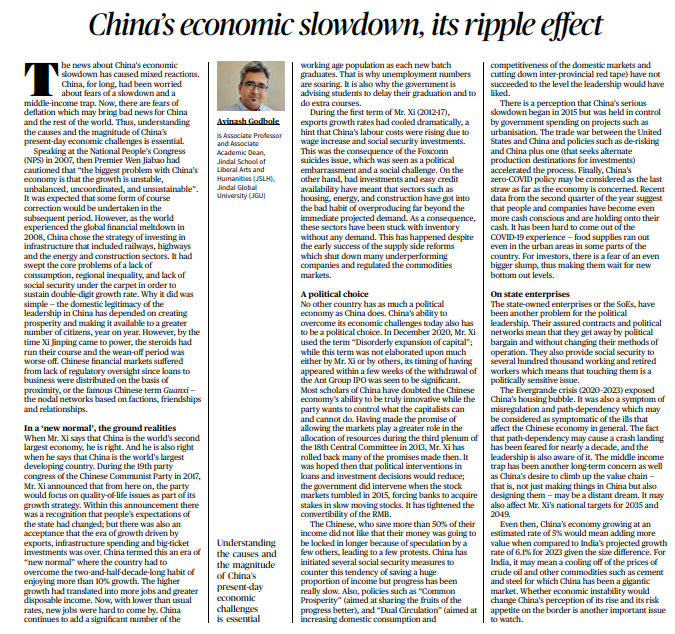TOPIC 1 - DEVIATION FROM ESTABLISHED PATTERNS IN INDIAN CRIMINAL LAW: IMPLICATIONS OF THE BHARATIYA NYAYA SANHITA, 2023
Introduction
- India’s criminal law often employs “special statutes” to address complex, impactful offenses, balancing harsh punishments with procedural safeguards.
- Recent legislative efforts, introducing the Bharatiya Nyaya Sanhita, 2023 (BNS) and related bills, signify a departure from this established pattern.
- This shift raises concerns about the fairness of the criminal justice system and the protection of individual rights.
Special Statutes vs. General Criminal Law
- Special statutes traditionally deal with complex offenses, such as the Prevention of Money Laundering Act, 2002 (PMLA) and the Maharashtra Control of Organised Crime Act, 1999 (MCOCA), offering procedural checks and balances.
- The recent bills, however, aim to absorb special laws into general criminal law without equivalent procedural safeguards.
Organised Crime Provision in BNS
- The BNS incorporates organized crime provisions into general criminal law, under Chapter VI dealing with “offenses affecting the human body.”
- It defines an organized crime syndicate as a group of three or more persons involved in serious offenses, racketeering, and syndicated organized crime.
Organized crime includes unlawful activities like kidnapping, robbery, land grabbing, contract
- killing, economic offenses, drug trafficking, and more.
Issues with BNS’s Definition
- The definition of organized crime in the BNS is vague, poorly worded, and overly inclusive.
- It lacks the precision that definitions in criminal law should possess.
Punishments Under BNS
- The BNS prescribes stringent punishments, including imprisonment for conspiring or organizing the commission of organized crime.
- However, it lacks the procedural safeguards present in special statutes like MCOCA.
Comparison with MCOCA
- MCOCA, a special statute, incorporates procedural safeguards to prevent abuse.
- For instance, it requires prior approval for recording information about organized crime, mandates the involvement of higher-ranking police officers, and establishes special courts with specific qualifications for judges.
- MCOCA also includes stringent privacy protection measures for wiretaps, overseen by a review committee.
Consequences of Absence of Safeguards
- The reforms proposed in the BNS weaken the principles of criminal law.
- The absence of procedural protections and checks and balances can lead to wrongful convictions and undermine the right to a fair trial and the rule of law.
- The general public stands to suffer as a result.
Conclusion
- The introduction of the Bharatiya Nyaya Sanhita, 2023, and related bills represents a significant deviation from established patterns in Indian criminal law.
- The absence of procedural safeguards and checks and balances raises concerns about the fairness and efficacy of the criminal justice system.
Upholding the principles of fair trial and the rule of law is crucial for preserving individual rights and maintaining public trust in the legal system.
CHINA'S ECONOMIC SLOWDOWN AND ITS IMPLICATIONS
Introduction:
- The news of China’s economic slowdown has generated mixed reactions, causing concerns not only within China but also globally.
- Understanding the causes and scale of China’s current economic challenges is crucial to grasp the significance of this slowdown.
Past Economic Policies and Challenges:
- In 2007, Premier Wen Jiabao highlighted the instability, imbalance, lack of coordination, and unsustainability of China’s economic growth.
- China’s response to the 2008 global financial crisis involved substantial investments in infrastructure, masking issues like low consumption, regional disparities, and social security deficits.
- The pursuit of double-digit growth to maintain domestic legitimacy led to overreliance on unsustainable strategies.
The “New Normal” and Economic Shifts:
- China’s recognition during the 19th party congress in 2017 that it needed to prioritize quality of life over export-driven growth marked a significant shift.
- The era of “new normal” called for adapting to growth rates below 10%, resulting in challenges like rising unemployment due to a growing working-age population.
Labor Costs and Overproduction:
- Labor costs rose as social security investments increased, impacting export growth rates.
- Sectors like housing, energy, and construction overproduced, leading to excess inventory despite supply-side reforms.
Political Choices and Economic Management:
- China’s unique political economy requires political choices to address economic challenges.
- Xi Jinping’s rollback of promises to allow markets to play a greater role highlights the party’s control over capitalist activities.
- Government interventions, such as during the 2015 stock market crisis, and currency restrictions, have been implemented.
Social Security Measures and Policy Outcomes:
- Despite efforts to reduce excessive saving, progress in implementing social security measures has been slow.
- Policies like “Common Prosperity” and “Dual Circulation” have not achieved the desired results.
Factors Contributing to the Slowdown:
- The slowdown, perceived to have started in 2015, was initially masked by government spending on urbanization.
- Factors like the U.S.-China trade war, de-risking strategies, and the zero-COVID policy exacerbated the economic downturn.
- Recent data suggests heightened caution among people and companies, leading to cash hoarding and delayed investments.
State-Owned Enterprises (SoEs) and Challenges:
- SoEs, due to their political networks and contracts, pose challenges for reforms and changes in their operations.
- These enterprises also provide social security, making them politically sensitive.
The Evergrande Crisis and Structural Issues:
- The Evergrande crisis exposed China’s housing bubble and highlighted misregulation and path-dependency issues.
- Path-dependency may lead to a crash landing for the Chinese economy, which has been a long-term concern.
Future Implications:
- China’s economic growth, even at a 5% rate, continues to add significant value globally.
- It may impact global commodity prices, including crude oil, cement, and steel, which could affect other economies.
- Economic instability could influence China’s perception of its rise and its risk appetite in border disputes.
Conclusion
China’s economic slowdown is a complex issue rooted in past policies, changing economic dynamics, and unique political considerations.
Understanding these challenges is crucial for assessing their potential impact on China and the world.


